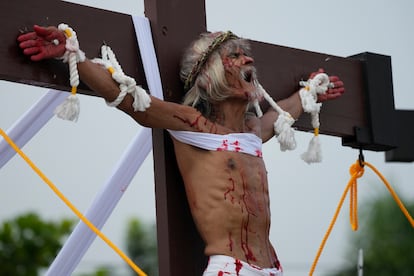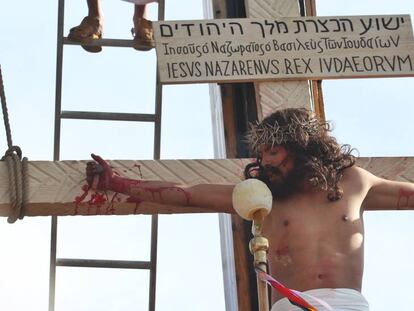Filipinos to be nailed to crosses despite church objection
At least 12 men would participate, including 62-year-old sign painter Ruben Enaje, who will be nailed to a wooden cross for the 34th time in Cutud and two other nearby villages, organizers said

At least 12 Filipinos are to be nailed to crosses to reenact Jesus Christ’s suffering in a gory Good Friday tradition that is rejected by the Catholic Church but draws huge crowds of devotees and tourists to the Philippines, an Asian bastion of Christianity.
The real-life crucifixions in the farming village of San Pedro Cutud in Pampanga province north of Manila were resuming after a three-year pause due to the coronavirus pandemic. At least 12 men would participate, including 62-year-old sign painter Ruben Enaje, who will be nailed to a wooden cross for the 34th time in Cutud and two other nearby villages, organizers said.
Enaje said he would use his extraordinary penance, probably among his last because of his age, to pray for the eradication of the Covid-19 virus and the end of Russia’s invasion of Ukraine, which has contributed to gas and food prices soaring worldwide.
“I really want to retire from this because of my age, but let’s see if my body can still bear the pain next year,” Enaje told The Associated Press a few days before the crucifixions.
The father of four has been portrayed in some media reports as among the bravest men in the world for the annual feat “but to be honest, I always feel nervous because I could end up dead on the cross.”
“When I’m laid down on the cross, my body begins to feel cold. When my hands are tied, I just close my eyes and tell myself, ‘I can do this. I can do this,’” he said.
Surviving nearly unscathed when he fell from a three-story building in 1985 prompted him to undergo the ordeal as thanksgiving for what he considered a miracle. He extended the ritual after loved ones recovered from serious illnesses, one after another, turning him into a village celebrity as the “Christ” in the Lenten reenactment of the Way of the Cross.
Ahead of their crucifixion on a dusty hill, Enaje and the other devotees, wearing thorny crowns of twigs, would carry heavy wooden crosses on their backs for more than a kilometer (more than half a mile) under the scorching heat. Village actors dressed as Roman centurions would later hammer 4-inch (10-centimeter) stainless steel nails through his palms and feet, then set him aloft on a cross under the sun for about 10 minutes.
Other penitents walk barefoot through village streets and beat their bare backs with sharp bamboo sticks and pieces of wood. Some participants in the past opened cuts in the penitents’ backs using broken glass to ensure the ritual was sufficiently bloody.
The gruesome spectacle reflects the Philippines’ unique brand of Catholicism, which merges church traditions with folk superstitions.
Many of the mostly impoverished penitents undergo the ritual to atone for sins, pray for the sick or for a better life, and give thanks for miracles.
Church leaders in the Philippines have frowned on the crucifixions and self-flagellations, saying Filipinos can show their deep faith and religious devotion without hurting themselves and by doing charity work instead, such as donating blood.
Robert Reyes, a prominent Catholic priest and human rights activist in the country, said the bloody rites reflect the church’s failure to fully educate many Filipinos on Christian tenets, leaving them on their own to explore personal ways of seeking divine help for all sorts of maladies.
Folk Catholicism has become deeply entrenched in the local religious culture, Reyes said, citing a chaotic procession of a black statue of Jesus Christ called the Black Nazarene each January, which authorities say draw more than a million devotees each year in one of Asia’s largest religious festivals. Many bring towels to be wiped on the wooden statue, believing it has powers to cure ailments and ensure good health and a better life.
“The question is where were we church people when they started doing this?” Reyes asked, saying the clergy should immerse itself in communities more and converse regularly with villagers. “If we judge them, we’ll just alienate them.”
The decadeslong crucifixions, meanwhile, have put impoverished San Pedro Cutud, one of the more than 500 villages in rice-growing Pampanga province, on the map.
Organizers said they expect about 20,000 foreign and Filipino tourists and devotees to gather for the cross nailings. As villagers peddled bottled water, hats, food and religious items, police and marshals kept order.
“They like this because there is really nothing like this on earth,” said Johnson Gareth, a British tour organizer, who brought 15 tourists from eight countries, including the United States, Canada and Germany, to witness the crucifixions. “It’s less gruesome than people think. They think it’s going to be very macabre or very disgusting but it’s not. It’s done in a very respectful way.”
In the past, Gareth said tourists were “genuinely inspired and I think they left with a newfound respect for people’s beliefs.”
Sign up for our weekly newsletter to get more English-language news coverage from EL PAÍS USA Edition
Tu suscripción se está usando en otro dispositivo
¿Quieres añadir otro usuario a tu suscripción?
Si continúas leyendo en este dispositivo, no se podrá leer en el otro.
FlechaTu suscripción se está usando en otro dispositivo y solo puedes acceder a EL PAÍS desde un dispositivo a la vez.
Si quieres compartir tu cuenta, cambia tu suscripción a la modalidad Premium, así podrás añadir otro usuario. Cada uno accederá con su propia cuenta de email, lo que os permitirá personalizar vuestra experiencia en EL PAÍS.
¿Tienes una suscripción de empresa? Accede aquí para contratar más cuentas.
En el caso de no saber quién está usando tu cuenta, te recomendamos cambiar tu contraseña aquí.
Si decides continuar compartiendo tu cuenta, este mensaje se mostrará en tu dispositivo y en el de la otra persona que está usando tu cuenta de forma indefinida, afectando a tu experiencia de lectura. Puedes consultar aquí los términos y condiciones de la suscripción digital.
More information
Últimas noticias
Most viewed
- Reinhard Genzel, Nobel laureate in physics: ‘One-minute videos will never give you the truth’
- Oona Chaplin: ‘I told James Cameron that I was living in a treehouse and starting a permaculture project with a friend’
- Pablo Escobar’s hippos: A serious environmental problem, 40 years on
- Chevy Chase, the beloved comedian who was a monster off camera: ‘Not everyone hated him, just the people who’ve worked with him’
- Why we lost the habit of sleeping in two segments and how that changed our sense of time










































